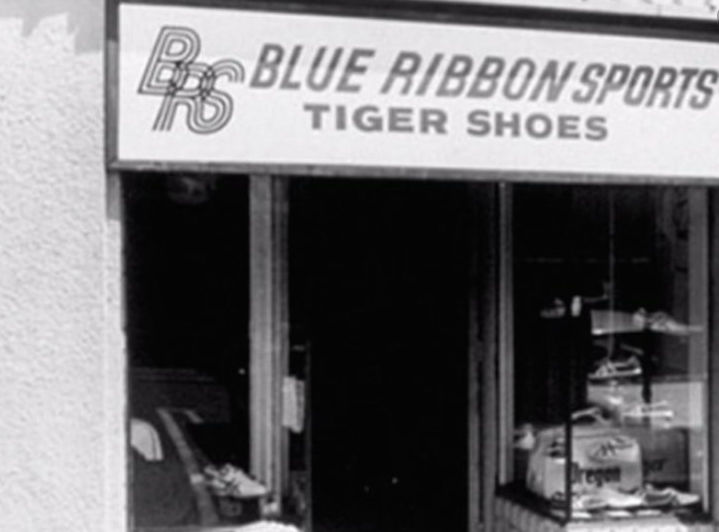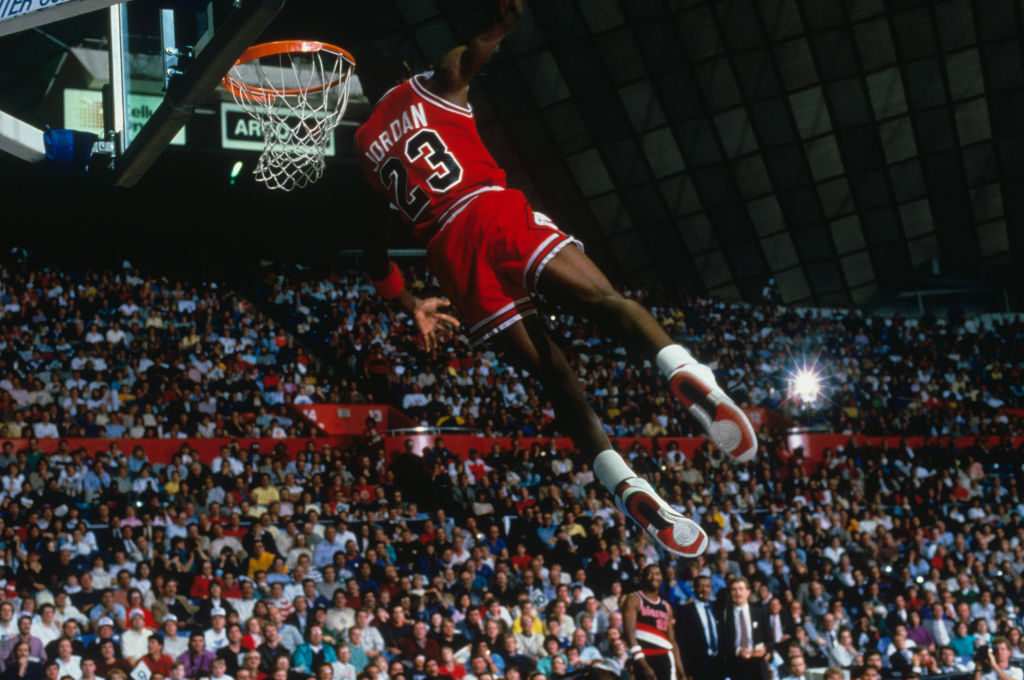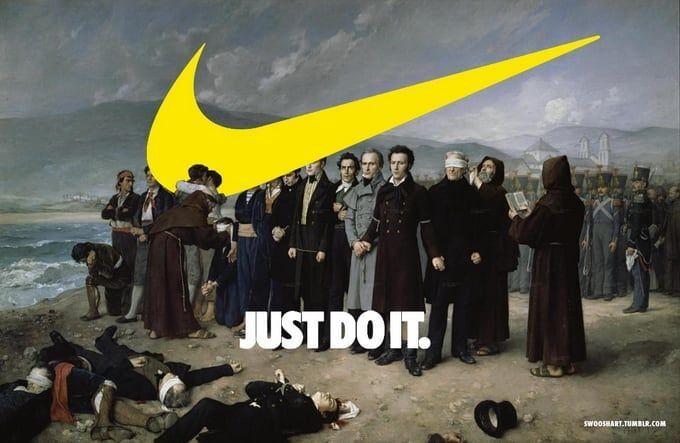General Info
Revenue/month – Approximately $3.83 billion
Founders – Phil Knight, Bill Bowerman
Employees – Over 83,000 employees globally.
Started in – 1964 (originally founded as Blue Ribbon Sports)

*Phil Knight (Left) and Bill Bowerman (Right)
Phil, when you look at Nike today, it’s far more than just a company that sells shoes. How did you transform what started as a small shoe distributor into the global empire it is now?
Nike, Inc. isn’t just in the business of selling shoes; we’re in the business of defining culture and driving innovation. When we started back in 1964, our focus was narrow—just getting high-quality running shoes into the hands of American athletes. But as we grew, we realized we could do much more. Today, Nike’s revenues have surpassed $46 billion as of 2023, and that’s because we’ve always had a clear vision and a relentless pursuit of excellence.
“Innovation distinguishes between a leader and a follower,” as Steve Jobs once said, and we’ve always embodied that philosophy. From the beginning, we’ve aimed to revolutionize the athletic world. We brought in cutting-edge technologies like air-cushioning early on, and now, we’re leaders in sustainability—over 70% of our products incorporate recycled materials.
But our impact goes beyond just sports. Nike has become a cultural force, shaping trends in fashion, music, and art. Take the Air Jordan line, for example; it’s more than just a shoe—it’s a cultural icon pulling in over $3 billion annually. Warren Buffett was right when he said, “Your premium brand had better be delivering something special, or it’s not going to get the business.” Nike’s story isn’t just about athletic achievement; it’s about understanding how to innovate, influence, and inspire on a global scale.
How did the idea for Nike originate?
It all started in the early 1960s when I was studying for my MBA at Stanford. As a middle-distance runner, I was intrigued by how German brands like Adidas dominated the athletic shoe market. I wrote a paper suggesting that high-quality, low-cost running shoes from Japan could disrupt the U.S. market. After graduating, I took action, traveled to Japan, and convinced Onitsuka Co. to let me distribute their Tiger running shoes in the U.S.
Back in the U.S., I partnered with my former track coach at the University of Oregon, Bill Bowerman. He was a relentless innovator, always experimenting with ways to enhance his athletes’ performance. Bowerman was already known for his unorthodox training methods and his obsession with creating better running shoes. We started Blue Ribbon Sports in 1964, selling shoes out of my car at track meets. Bowerman’s innovation led to the creation of the “waffle sole,” inspired by his wife’s waffle iron, which became a cornerstone of our success.

When did Nike officially come into existence?
By 1971, our business was growing rapidly, and we decided it was time to rebrand. We chose the name “Nike,” after the Greek goddess of victory, and introduced the iconic “Swoosh” logo. The first shoe we designed ourselves was the Nike Cortez, launched in 1972. It quickly became a sensation, propelling us into the spotlight.
How did you go about designing Nike’s first products?
The design process was very hands-on and innovative. Bill Bowerman was deeply passionate about improving athletic performance. He started experimenting in his workshop, even using his wife’s waffle iron to create the now-famous “waffle sole,” which offered superior traction and cushioning.
How did you refine those early prototypes?
Bowerman’s prototypes were developed with input from athletes, including his own runners. We focused on enhancing performance, comfort, and durability. The feedback from these athletes was crucial; it helped us rigorously test and refine the designs to better meet their needs and preferences. This iterative process was key to creating shoes that truly made a difference.
How did you find your Initial Customers?
I have to agree that I was lucky when it came to finding the initial customers, but these are some approaches we used:
1. Direct Sales: We started with a very direct approach. In 1964, Bill Bowerman and I launched Blue Ribbon Sports and began selling shoes directly from the trunk of my car at track meets and local events. This hands-on method allowed us to engage directly with our target market—runners—and gather invaluable feedback.
2. Track Meets and Running Clubs: We leveraged our networks by connecting with track coaches, runners, and running clubs. This grassroots approach helped us build credibility and trust within the running community.
3. Word of Mouth: The quality and performance of our shoes led to word-of-mouth recommendations. As more athletes experienced the benefits of our designs, they shared their positive feedback, which helped us expand our reach and build a loyal customer base.
Nike has achieved remarkable global dominance. Could you share what strategies and innovations have been key to attracting and retaining customers since the company’s launch?
Certainly. Nike has masterfully crafted its global dominance through a blend of strategic innovation and deep consumer connection. At the heart of our success is innovative product design; technologies like Air Max, first introduced in 1987, have not only revolutionized comfort but also defined an era of sneaker culture. Meanwhile, Flyknit, which reduces waste by 60% compared to traditional footwear manufacturing, reflects our commitment to both performance and sustainability.
Our strong identity is anchored in the iconic “Swoosh,” a symbol recognized worldwide. Advertising campaigns like “Just Do It,” launched in 1988, resonate deeply, turning Nike from just a brand into a source of inspiration. Our partnerships with athletes like Michael Jordan have paid off immensely—the Air Jordan line alone brings in over $3 billion annually. As one loyal fan puts it, “Wearing Nikes isn’t just about the shoes; it’s about feeling like you’re part of something bigger.“

* Legendary Michael Jordan wearing NIKE
Nike’s diverse product range ensures that there’s something for everyone, whether you’re a professional athlete or a weekend warrior. This variety is supported by an expansive retail and e-commerce presence; with over 1,100 stores globally and a robust online platform, Nike ensures customers have easy access to our products.
Moreover, the NikePlus program offers personalized experiences and exclusive access to products, fostering a sense of belonging among our 100 million members. A longtime customer shared, “NikePlus makes me feel valued—like the brand actually cares about my experience.“
Finally, our commitment to sustainability is not just a corporate responsibility—it’s a key part of our appeal. Over 70% of Nike products now incorporate recycled materials, aligning with the values of environmentally-conscious consumers. This multifaceted approach, blending innovation with a deep understanding of what customers value, has not only attracted a loyal customer base but also built a brand that feels personal to millions around the world.
Nike has consistently performed at the top of its game. How is Nike doing today, and what does the future look like?
Today, Nike is not just surviving but thriving as a global powerhouse, with a market value surpassing $160 billion. In 2023 alone, we generated over $46 billion in revenue, reaffirming our position as a leader in the sportswear industry. Nike continues to dominate the athletic footwear market, capturing nearly 40% of global market share. From professional athletes to everyday fitness enthusiasts, Nike remains the go-to brand.
 * These stats are not accurate!
* These stats are not accurate!
Looking to the future, our trajectory is set for continued success, driven by key strategic initiatives:
-
Digital Transformation: We have embraced the digital age with vigor. Digital sales now account for over 25% of our total revenue, reflecting a shift toward direct-to-consumer (DTC) strategies. Our digital platforms, including the Nike app and NikePlus membership, are driving this growth. As CEO John Donahoe noted, “Digital is fueling how we create the future of Nike. It’s the connective tissue that bridges innovation, product, and consumer experience.”
-
Sustainability Initiatives: Our commitment to sustainability is not just about responsibility; it’s a strategic advantage. We are on a mission to achieve zero carbon and zero waste as part of our “Move to Zero” campaign. Currently, over 70% of Nike products incorporate recycled materials. This move resonates strongly with today’s consumers, who increasingly prioritize environmental impact. “Sustainability is not just something we do; it’s how we operate,” said our Chief Sustainability Officer, Noel Kinder.
-
Innovation in Products: Innovation has always been at Nike’s core, and the future is no different. We continue to push boundaries with new technologies and materials. For instance, the Nike Fit app, which uses AI to recommend the perfect shoe size, is revolutionizing the customer experience. “We innovate to inspire, and to make athletes better,” says Tinker Hatfield, one of Nike’s legendary designers.
-
Global Expansion: Our growth isn’t limited to our traditional strongholds. We are aggressively expanding in emerging markets, with a special focus on China and India. In China alone, we saw a double-digit growth in 2023, thanks to localized products and culturally resonant marketing. Our strategy of “thinking globally, acting locally” is paying off handsomely.
If there is one piece of advice you could give to someone looking to enter the footwear industry, what would it be?
My advice would be to deeply understand and prioritize the intersection of innovation and consumer needs. The footwear industry is highly competitive and constantly evolving, so it’s crucial to offer something that not only stands out but also genuinely addresses the needs and desires of your customers.
Start by investing in research and development to explore new technologies and materials that can enhance comfort, performance, and style. Equally important is building a brand that resonates emotionally with consumers—create a strong, authentic identity that reflects your values and connects with your target audience on a personal level.
Additionally, focus on creating an exceptional customer experience both online and offline. From a seamless purchasing process to outstanding customer service, every touchpoint should reinforce the quality and ethos of your brand.
Lastly, be prepared to adapt and innovate continuously. The footwear market is dynamic, and staying ahead requires agility and a willingness to embrace new trends and technologies. By balancing innovation with a deep understanding of consumer preferences, you can carve out a successful niche in this exciting industry.
Some Key Insights for Future Entrepreneurs
Building an empire as great as Nike requires vision, innovation, and execution. Here’s how:
-
Develop a Clear Vision and Mission: Start with a compelling vision that inspires, like Nike’s goal to “bring inspiration and innovation to every athlete* in the world” (*If you have a body, you are an athlete).
-
Innovate Relentlessly: Focus on product innovation and a consumer-centric approach. Nike’s continuous innovation, like Air Max and Flyknit, keeps us ahead.
-
Build a Strong Brand Identity: Create an iconic brand that stands for something bigger than products. Nike’s “Swoosh” and “Just Do It” are symbols of empowerment.
-
Leverage Influential Partnerships: Strategic endorsements with athletes and influential figures, like Michael Jordan, build cultural relevance.
-
Master Marketing and Storytelling: Use emotional storytelling and digital engagement to connect with your audience. Nike’s campaigns resonate deeply with consumers.
-
Focus on Quality and Customer Experience: Ensure product excellence and create exceptional customer experiences, both online and offline.
-
Sustainability and Social Responsibility: Build a purpose-driven brand that contributes positively to society, like Nike’s “Move to Zero” sustainability campaign.
-
Scale Smartly: Expand globally with strategy and maintain operational efficiency through technology and supply chain management.
-
Embrace Technology and Innovation: Integrate technology into your business, using digital platforms and data-driven decisions to stay ahead.
-
Cultivate a Strong Company Culture: Empower your team with a strong, motivated culture that drives innovation and growth.
-
Adapt and Evolve: Be resilient and adaptable, continuously learning and evolving to navigate challenges and seize new opportunities.
By focusing on these key strategies, you can build a brand that becomes a global icon, just like Nike.


Leave a Reply